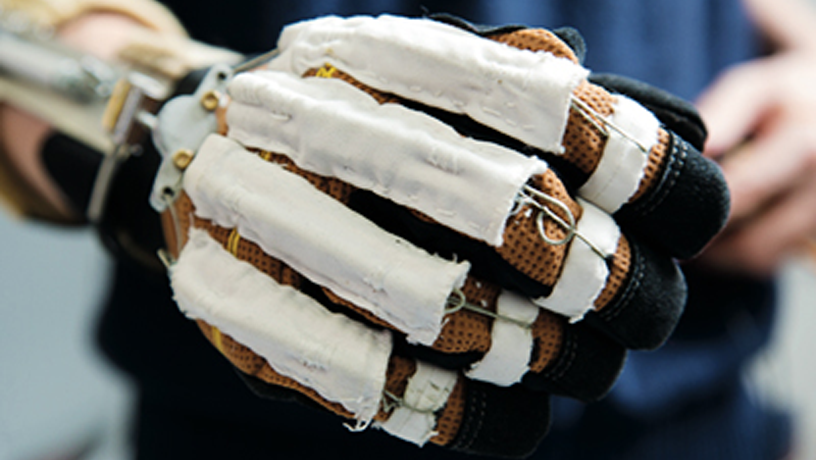Hands-On Robotics
As a boy, Matei Ciocarlie, assistant professor of mechanical engineering, loved to build things—Legos were his favorite toy. He was also fascinated by computer programming and algorithms. Once he discovered robotics as a student, his path was set: Robots were the perfect conduit for giving computer programs a physical presence in the world, a way to express intelligence through physical interaction with the environment.

Prototype of a wearable hand orthosis, developed by Matei Ciocarlie’s lab in collaboration with Dr. Joel Stein (Columbia University Medical Center), used to assess the level of force needed to assist hand extension in stroke patients (Photo by Jeffrey Schifman)
“Robotics, like few other fields,” he explains, “combines the study of the body and the mind: the physical mechanism and the algorithms that control it. There can be intelligence at the mechanical level just like at the computational level. And, put together, the body and the mind are much more than the sum of the parts.”
Human hands are a perfect case in point. “They are marvelous from a mechanical perspective, equipped with sensors far surpassing our current technology; and, when controlled by the human brain, incredibly versatile,” he continues. “If we can match the abilities of the human hand, then I think we’ve achieved true intelligence in an artificial mechanism.”
A major focus of Ciocarlie’s research has been on developing versatile manipulation and mobility in robotics, in particular on building dexterity into robotic hands, and he is on a roll. In the past three years alone, he has won an array of prestigious honors, including the 2013 IEEE Robotics and Automation Society Early Career Award, a 2015 Young Investigator Program grant from the Office of Naval Research, a 2015 NASA Early Stage Innovations grant, a 2016 CAREER Award from the National Science Foundation (NSF), and, most recently, a Sloan Fellowship.
Working in his new Robotic Manipulation and Mobility Lab, Ciocarlie and his students are using robotics to change the world. While robots have already made a huge impact by reliably executing perfectly repeatable tasks such as assembly and manufacturing, he thinks it is now critical for robots to become more versatile and to learn to handle variability and interact with the world more intelligently. Researchers have been focused on robotic locomotion and navigation, but it is no longer enough that robots can move through an environment independently.
Ciocarlie sees robotic manipulation in unstructured environments as a critical research area. “We need to effect physical change on the world not just by moving bodies but by moving things around as well,” he says. His group is working on a range of applications that are part of everyday life—from versatile automation in manufacturing and logistics, to mobile manipulation in unstructured environments, to assistive and rehabilitation robotics in health care.
Ciocarlie’s NSF CAREER Award is enabling him to explore the fundamental science of manipulation, to develop better tools to make assessments of the mechanisms and methods that enable versatile object acquisition—the process of planning a grasp and then executing it with a hand mechanism to pick up the desired target. His concept is a departure from the “build, then program” paradigm, where the hardware and software components of a manipulator are developed either sequentially or independently.
“If we can optimize mechanism designs jointly with planning and control algorithms, using combined quality metrics, then we’ll be able to build versatile hands ready for use right after assembly, already known to perform a broad range of useful tasks,” he says. “This would make a big difference in areas such as consumer electronics manufacturing, logistics, health care, and even at home.”
Ciocarlie is also working with NASA and his colleague Michael Massimino, former NASA astronaut and professor of professional practice in the Department of Mechanical Engineering, to expand the manipulative capabilities of robots in space. The so-called Assistive Free-Flyers (AFFs) are designed to share space with astronauts on board the International Space Station, helping with sensing and observation tasks such as surveillance, inspection, and mapping. Ciocarlie’s team is developing compact yet dexterous robotic arms and hands, along with the planning and control methods needed to operate them, with Massimino providing critical domain expertise. The idea is to demonstrate new capabilities on such tasks as object acquisition and transport, part insertion and extraction, button or lever operation, docking and perching. “We believe these abilities will greatly increase AFFs’ reach, literally and figuratively,” Ciocarlie quips.
Health care is another big area of focus for Ciocarlie, who is collaborating on an orthotics project with Joel Stein, chair of the Department of Rehabilitation and Regenerative Medicine at Columbia University Medical Center. There are close to 800,000 new stroke victims in the United States every year, and about a third of them do not regain useful function of their upper limbs. Ciocarlie and Stein are developing a wearable device to help with rehabilitation and assistance, one that is simultaneously dexterous for complex manipulation, nonintrusive for daily living, and intuitive to control. They are hopeful their technology will help not only stroke victims but also people with other degenerative conditions that affect manipulation, including myopathies, motor neuron disorders, multiple sclerosis, and others.
“Unlike the elbow and the knee,” Ciocarlie notes, “the hand is uncharted territory for wearable assistive technologies because it is so complex—there are so many degrees of freedom needed in such a small package. In fact, I often tell people when they look at a Ferrari or Mercedes and say, ‘Oh, that’s an amazing piece of equipment,’ that the human hand is a much more amazing piece of equipment and most of us are blessed with two of them that function!”

Matei Ciocarlie and students in the Robotic Manipulation and Mobility Lab (Photo by Jeffrey Schifman)
